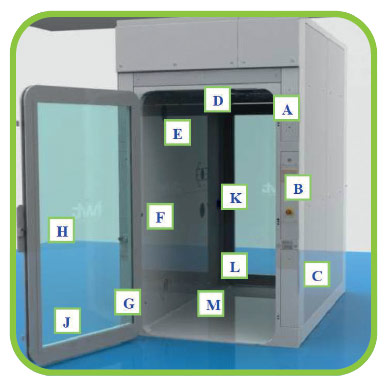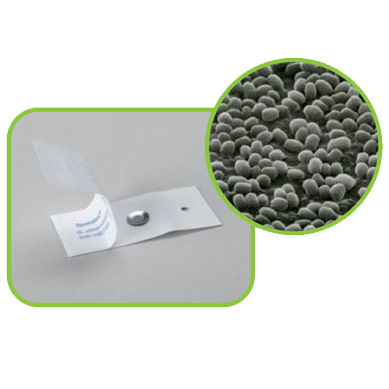
The current version of the Tecniplast website doesn't match your region. Please visit your local website to find information and offerings specific to your country.

The current version of the Tecniplast website doesn't match your region. Please visit your local website to find information and offerings specific to your country.

 The simplest compound for achieving a reliable and effective low-temperature bio-decontamination
The simplest compound for achieving a reliable and effective low-temperature bio-decontamination
In this third and last episode of the hydrogen peroxide’s saga, it will be argued how to face bio-decontamination cycle validation activities. When a system equipped with an automatic airborne disinfection system is sold, the supplier must also perform the bio-decontamination cycle validation, which can be divided into two phases:
Cycle Development, the procedure that allows to find a suitable recipe as a base for performance qualification purpose.
Performance Qualification, the cycle implemented according to the cycle development outcomes is run three times using biological and chemical indicators for demonstrating:
Recipe
Vapour phase hydrogen peroxide cycle development outcome is a set of parameters defining at least the duration, the injection rate and flow rate of the bio-decontamination cycle phases:
he set of parameters which define each phase is called recipe. For instance, the Rising phase and the Plateau phase must be defined at least by the H2O2 injection rate, the air flowrate, and the phase total duration. The warm-up and aeration must be defined at least by the air flowrate, and the duration of the phase. If the system is equipped with relative humidity and hydrogen peroxide concentration sensors, the warm-up and aeration phases can last until RH% and H2O2 ppm reach the desired level. If we consider a bio-decontamination based on aerosolized hydrogen peroxide technology, the recipe is slightly different:
Challenge Points
The first activity carried out and documented during the Cycle Development is the definition of the load, which is made up of tools, disposable, miscellaneous, and whatever has to be bio-decontaminated by hydrogen peroxide. The environment (room, labs, isolator, pass-through, pass-box) and its load must be analysed to identify the “challenge points”, that is those points in which cycle effectiveness may not be optimal (corners, filters, hard-to-reach area, etc…). The environment and its load are then mapped according to the worst scenario approach, which means that if the bio-decontamination method is effective against the challenge points, it must be effective for all other locations.
There is no indication about the minimum number of points to be identified, nevertheless the mapping must have a good balance between an excessive number of points, which could lead to a waste of time and increase the risk of errors, and a poor mapping, which could give a not representative result. In any case the mapping of the environment and its load must be decided and documented together with the final user. Each point must be identified and labelled before proceeding with the indicators’ placement.
Indicators
Once all positions are established, it is necessary to test the recipe to verify the correct decontaminant distribution through the environment and its load and, more important, to test the decontaminant efficacy. Decontaminant uniformity is tested using chemical indicators (CI).

Chemical Indicator is a substance that gives a visible sign, usually by a color change, of the presence or absence of a certain concentration of Hydrogen Peroxide (mg/ml), normally placed on a mechanical support, like paper strip or adhesive.
Bio-decontamination cycle efficacy is tested using biological indicators (BI).
Biological Indicator is a test system that contains viable microorganisms with a defined resistance (D-Value) to sterilization process.
Mostly of BIs are stainless steel coupons or paper strips inoculated with a certificated population (typically 106, 105 or 104) of viable spores of Geobacillus Stearothermophilus. To ease handling, BIs are often wrapped in Tyvek and nowadays they can be considered an industrial standard.
Why Geobacillus Stearothermophilus?
Cycle validation pitfalls
The concept of Micro Condensed Hydrogen Peroxide (MCHP), introduced in the first episode, helps to explain the chemical and physical mechanisms behind the extraordinary decontamination power of airborne hydrogen peroxide, both in vapour and aerosol state. MCPH is an invisible layer of micro-droplets with high concentration of hydrogen peroxide (MCHP) and its formation is facilitated under certain conditions. For this reason, VPHP is not only a time-concentration based process, but it is strongly influenced by the environmental condition, such as humidity, temperature, pressure and contact materials. Understanding how the several variables influence the cycle outcome is essential for a cycle validator. The higher the following parameters, the higher the cycle efficacy, because the formation of MCHP is facilitated.
On the other hand, a temperature increase reduces the cycle efficacy.
Although a high level of relative saturation is beneficial, frank condensation should be avoided. The trick is to stay close, but below, the dew point.
Typical pitfalls during cycle development are:
Despite being now more than 30 years since the first gas phase sanitization process has been applied to an isolator, Vapour Phase Hydrogen Peroxide (VPHP) process continues to seem rather complex, and the cycle development appears almost mystical. This is because of failure to understand exactly how the VPHP works, in fact VHPS is quite simple.
MARCO PAGANI - MARKETING & COMMUNICATION MANAGER IWT SRL